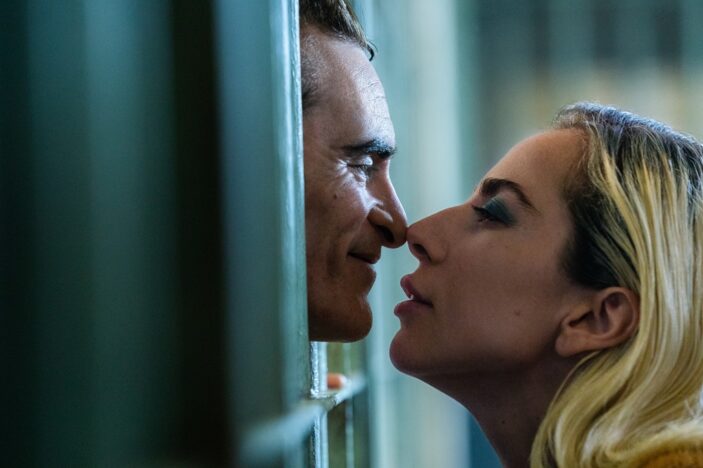
In the same way that it was quite the baffling result that 2019’s Joker “laughed” its way to a billion dollar haul at the box office, Joker: Folie à Deux and all its “Fuck you” energy to WB fandom and mainstream appeal is a strikingly anti-audience effort that deserves praise for being so bold with its mentality, but not for its final result as a narrative we can invest in.
Whether or not writer/director Todd Phillips has anything intentional to say or not with his off-putting psychological drama is best left to the audiences to decipher, but the fact that he’ll no doubt herd said audiences to theatres this weekend for a film that’s so aggressively subversive and oppositional to what the fans expect is the biggest laugh of all; and it’s the only one this taxing sequel is going to get.
Following his slew of slayings across the first film – which ended in the public execution of Robert De Niro’s judgemental talk show host Murray Franklin – Arthur Fleck (Joaquin Phoenix, once again turning in a fine performance of unnerving proportion), aka Joker, has been committed to Arkham Asylum where he awaits his trial for said murders. The guards, led by Brendan Gleeson‘s Jackie Sullivan, have a field day in tormenting Arthur throughout, and it’s only when he’s allowed to visit the minimum security ward that he earns a sense of reprieve.
It’s also here that he meets Lee (Lady Gaga, fine, though incredibly underutilised), a seeming pyromaniac of sorts who has developed an obsession for Arthur and all that he stands for. The two fall for each other in an alarmingly quick amount of time (for a movie that runs at 138 minutes it’s quite surprising how little time they devote to these two actually getting to know each other), and, because Phillips and Scott Silver‘s script would have us believe everyone working at the asylum is wildly incompetent at their jobs, Lee starts a fire in their recreation room, escapes with Arthur in tow, and they burst into a song and dance number that should play out in Arthur’s mind (like many of these musical sequences do) but is ultimately revealed to be a part of their reality; it’s scenes like this and where a guard openly lets Lee into Arthur’s cell that add to the film’s overall illogicality.
When Joker: Folie à Deux was announced as a musical – though so many of the creatives involved refuse such an apt description of its tone – it was met with a mixed reception. Seeing how the original film ended, Phillips’ choice to musicalise the next chapter of Joker’s story isn’t so out of the realms of possibility. And the fact that so much of Arthur’s existence is him retreating into his own mind for comfort, the use of musical sequences to express such emotion, again, makes sense in the grand scheme of this storytelling. Such a choice would be valid thought if it didn’t play so fast and loose with its own concept, with Phillips shoehorning in musical sequences when it benefits to pad the running time and, more so, showcase Gaga’s vocals.
When Arthur retreats into himself and behaves freely, we are treated to some genuinely interesting moments. And when the film focuses specifically on his trial and whether or not he should be held accountable on the ground of his questioned sanity, Joker: Folie à Deux proves a worthy continuation. Less successful is the inclusion of Gaga as Lee. This universe’s take on Harley Quinn, there’s all the potential for a fascinating character to be created here, but, for whatever reason, Phillips and Silver opt to remove all the intrigue behind what makes their characters attraction to one another so psychologically beguiling. She readily admits she’s obsessed with Arthur, but we never find out why, and given that Harley Quinn as a character has a background as a psychiatrist, it’s a wasted opportunity to not flirt with this notion in some capacity. Even in the musical numbers she’s not nearly as captivating as we know she can be, though that feels like it’s more on Phillips’ direction, as Hildur Guðnadóttir has created a beautifully haunting score and Lawrence Sher‘s cinematography layers the film with as much boon as possible. Tragically, you could remove Gaga and the character of Lee from the story and very little is ultimately altered.
Whilst the first film was hardly an enjoyable experience thematically, it’s positively beaming with levity in comparison to this. Joker: Folie à Deux is a numbingly depressing experience that can’t say it’s been made for the fans, but also doesn’t seemingly have an intended audience in mind regardless. It so clearly wants to explore Arthur’s psyche as to who he really is in relation to the Joker persona – or is Arthur merely the Joker’s shadow? – and the moments it showcases genuine interest in his well-being are too far and few between that it can’t even guarantee we’ll have the interest across the remaining board.
A waste of Phoenix’s commitment and Gaga’s talent, with an ending that would probably incite riots if audiences actually cared by such a point, Joker: Folie à Deux takes the biggest of swings, without question, and almost deserves respect for its blatant rebellion, but its indecisiveness in what it wants to do or say leaves us waiting on a punchline that limps rather than lands.
![]()
![]()
![]()
![]()
![]()
TWO STARS (OUT OF FIVE)
Joker: Folie à Deux is now screening in Australian theatres.
